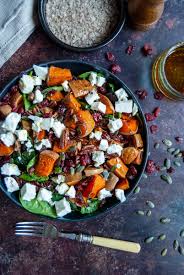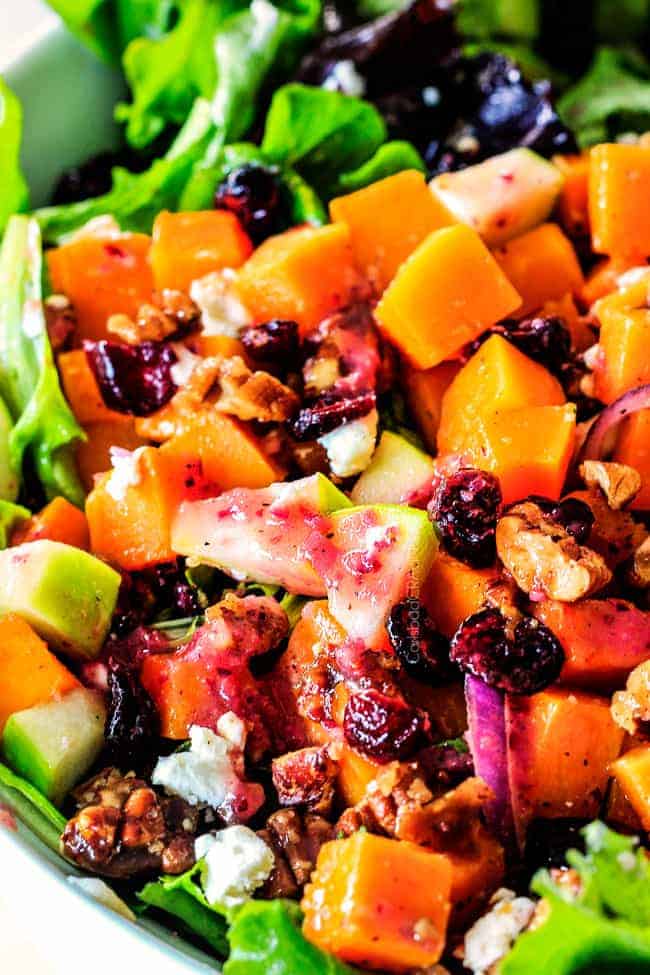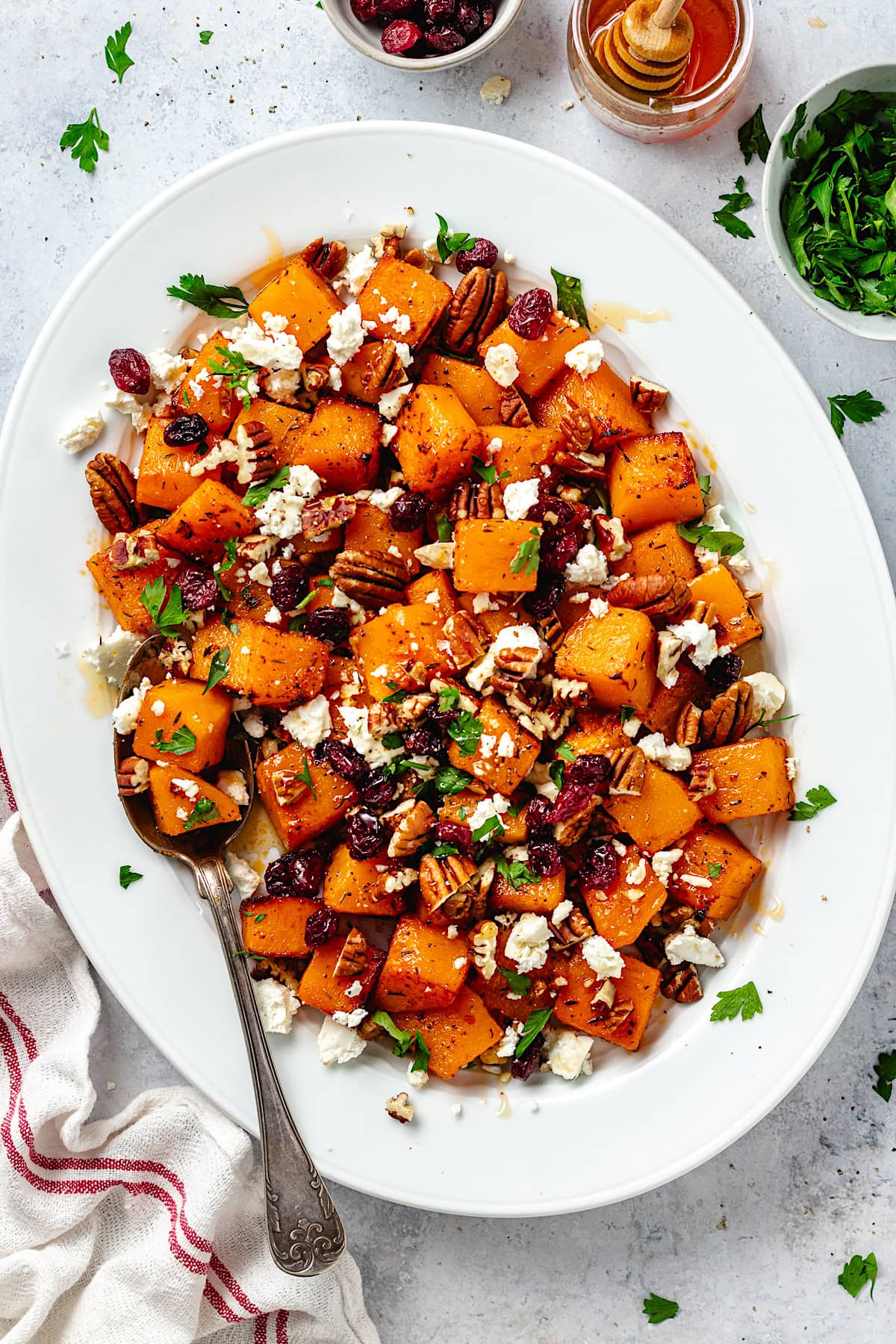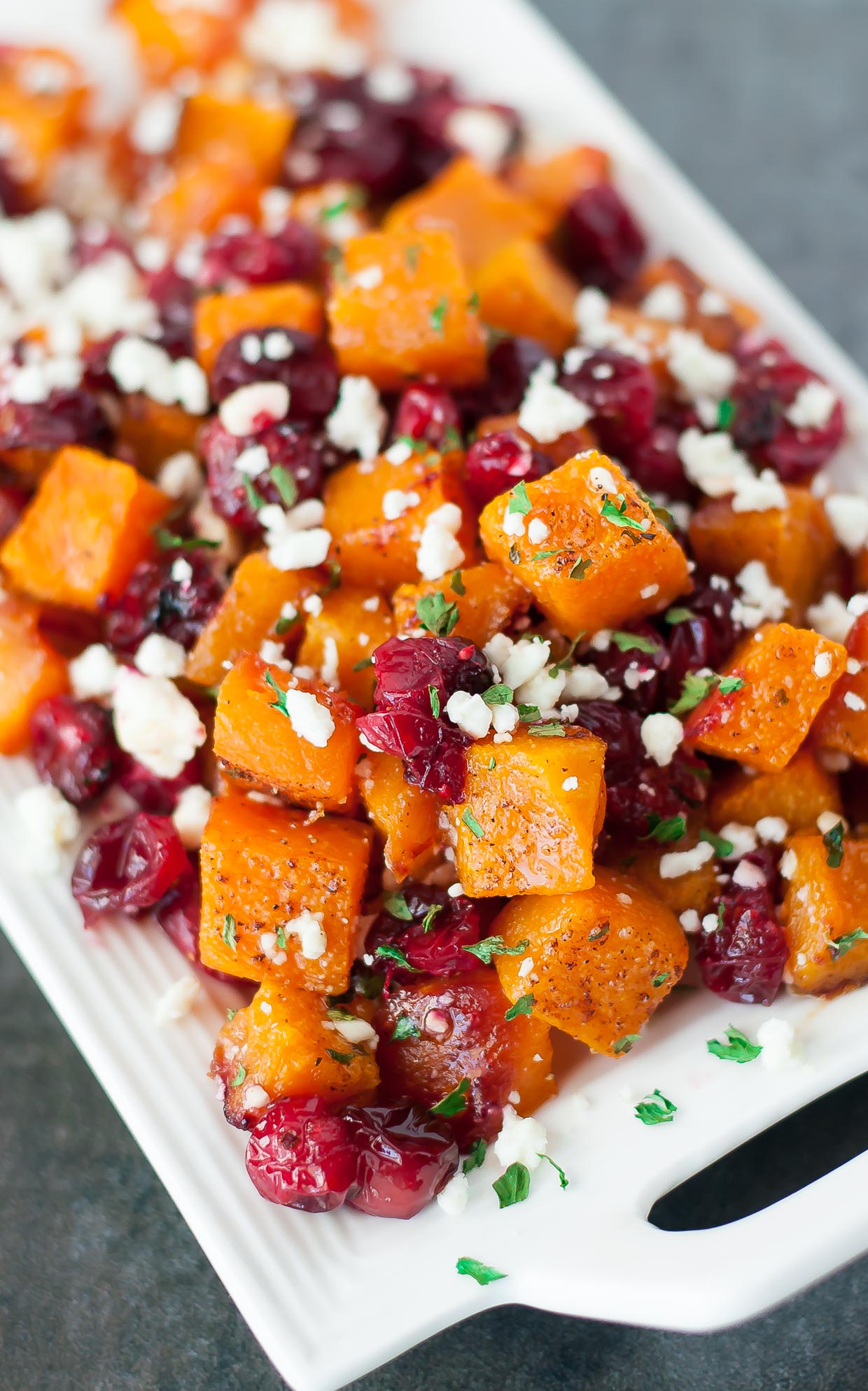
A close-up of honey-roasted butternut squash mixed with tart cranberries and creamy feta, showcasing the dish’s colorful appeal.
Butternut Squash the leaves turn golden and the air grows crisp, nothing captures the essence of autumn quite like a hearty, flavorful salad that blends the sweetness of roasted vegetables with the tang of seasonal fruits. The Roasted Butternut Squash and Cranberry Salad is a perfect embodiment of this seasonal transition, offering a medley of textures and tastes that can elevate any meal. Whether you’re preparing it as a side dish for a family gathering, a light lunch, or even a festive holiday spread, this salad promises to impress with its simplicity and depth of flavor.
Butternut Squash , with its creamy, nutty flesh, takes center stage after being roasted to caramelized perfection. Paired with dried cranberries that add a burst of tart sweetness, this dish strikes a balance that’s both comforting and refreshing. Often enhanced with crunchy nuts like pecans, creamy cheese such as feta or goat cheese, and a zesty dressing, it’s a versatile recipe that can be adapted to suit various dietary preferences. According to popular recipes, this salad has gained traction in recent years as a healthy alternative to heavier fall dishes, appearing in blogs and cookbooks focused on seasonal eating.
In this comprehensive guide, we’ll dive deep into everything you need to know about creating this salad. From its historical roots in autumnal cuisine to step-by-step instructions, nutritional insights, and creative variations, this article is designed to equip you with the knowledge to make it your own. Butternut Squash you’re looking for more fall-inspired recipes, check out our internal collection of autumn salads or explore external resources like the USDA’s guide to seasonal produce at https://tastetrove.net.
The beauty of this salad lies not just in its taste but in its ability to bring people together. Imagine serving it at Thanksgiving, where the vibrant orange squash contrasts beautifully with ruby-red cranberries, creating a visual feast before the first bite. It’s gluten-free by nature, easily vegan-adaptable, and packed with nutrients that support wellness during colder months. Over the next sections, we’ll explore why this dish has become a staple in modern kitchens and how you can perfect it at home.
To truly appreciate this salad, let’s consider the sensory experience it offers. The roasting process fills your kitchen with warm, earthy aromas, while the combination of soft squash, chewy cranberries, and crisp greens provides a satisfying mouthfeel. It’s a dish that encourages mindfulness in eating—savoring each component’s unique contribution. As food trends evolve, Butternut Squash like this one highlight a shift toward plant-based, whole-food meals that don’t compromise on indulgence.
Historically, butternut squash has been a cornerstone of North American cuisine since its cultivation by indigenous peoples centuries ago. Cranberries, native to the same region, were used in traditional pemmican and later popularized in colonial recipes. Combining them in a salad is a contemporary twist, but one rooted in these ingredients’ shared heritage. This fusion represents the evolution of American foodways, blending old-world techniques with new-world flavors.
If you’re new to cooking with squash, don’t worry—this article will guide you through selection, preparation, and common pitfalls. For those seasoned in the kitchen, we’ll offer advanced tips to elevate the dish further. By the end, you’ll have a recipe that’s not only delicious but also customizable to your pantry and preferences.
The History and Cultural Significance of Butternut Squash and Cranberries
Butternut squash (Cucurbita moschata) traces its origins to the Americas, where it was domesticated over 5,000 years ago by Mesoamerican cultures. Archaeological evidence suggests it was a dietary staple for ancient civilizations, valued for its long storage life and versatility. European settlers encountered it through Native American tribes, who taught them cultivation methods. By the 19th century, butternut squash had become a common vegetable in American farms, prized for its sweet flavor and nutritional density.
Cranberries, on the other hand, are one of the few fruits native to North America, growing in bogs across the northeastern United States and Canada. Indigenous peoples like the Algonquin and Wampanoag used them for food, medicine, and dye, often mixing them with dried meats or fats. The Pilgrims learned about cranberries during the first Thanksgiving in 1621, incorporating them into their meals. Commercial cultivation began in the early 1800s in Massachusetts, leading to the iconic cranberry sauce we know today.
The pairing of butternut squash and cranberries in a salad is a modern innovation, emerging in the late 20th century amid the rise of health-conscious cooking. Food bloggers and chefs began experimenting with roasted vegetables in salads during the 1990s, influenced by Mediterranean and California cuisines. Recipes like this one gained popularity through platforms like Pinterest and food networks, emphasizing seasonal, farm-to-table ingredients.
Culturally, this salad embodies fall festivals and harvest celebrations. In the U.S., it’s often featured at Thanksgiving tables as a lighter alternative to starchy sides. In Canada, similar dishes appear during harvest suppers. Globally, variations can be found in European autumn menus, where squash is roasted with local berries. For more on the history of squash, visit Wikipedia’s page on butternut squash. Internally, link to our article on native American ingredients for deeper insights.
This combination also reflects broader trends in sustainable eating. Both ingredients are hardy, requiring minimal water compared to other crops, making them eco-friendly choices. As climate change impacts agriculture, recipes like this promote resilient, local produce.
Essential Ingredients for the Perfect Salad

somethingsweetsomethingsavoury.com
A beautifully arranged bowl of roasted butternut squash salad with pecans, feta, and cranberries on a bed of greens.
Selecting high-quality ingredients is key to this salad’s success. Start with a medium-sized butternut squash—about 3 pounds—ensuring it’s firm and heavy for its size, with matte skin free of blemishes. Peel and cube it into 1-inch pieces for even roasting.
Dried cranberries add tartness; opt for unsweetened varieties to control sweetness, or fruit-sweetened ones for a natural boost. About 1 cup is ideal for 4-6 servings.
For crunch, pecans are a classic choice, but walnuts or pumpkin seeds work well too. Toast ½ cup to enhance their nutty flavor.
Cheese provides creaminess—feta or goat cheese (4 ounces crumbled) offers a tangy contrast. For vegan options, use plant-based alternatives.
Greens form the base: Kale, spinach, or arugula (6 cups) add freshness. Massage kale with oil to soften it.
The dressing ties it all together. A simple vinaigrette of ¼ cup olive oil, 2 tablespoons balsamic vinegar, 1 tablespoon maple syrup, salt, pepper, and a teaspoon of Dijon mustard creates a harmonious blend.
Optional add-ins include red onion for sharpness, apples for crispness, or quinoa for protein. Source ingredients from local markets for freshness; check our ingredient sourcing guide internally, or external sites like Farmers’ Market Directory.
Each ingredient contributes nutritionally: Squash is rich in vitamin A, cranberries in antioxidants, nuts in healthy fats.
Step-by-Step Preparation and Cooking Instructions
Preparing this salad is straightforward but requires attention to roasting for optimal flavor.
Step 1: Preheat and Prep the Squash
Preheat your oven to 400°F (200°C). Peel the butternut squash using a sturdy peeler, halve it lengthwise, scoop out seeds, and cut into 1-inch cubes. Toss with 1-2 tablespoons olive oil, salt, pepper, and optional spices like cinnamon or garlic powder. Spread on a parchment-lined baking sheet in a single layer to ensure even caramelization.
Step 2: Roast the Squash
Roast for 25-30 minutes, flipping halfway, until tender and edges are golden. This step concentrates the squash’s natural sugars, creating a sweet, caramelized exterior while keeping the interior soft.
Step 3: Prepare the Add-Ins
While roasting, toast pecans in a dry skillet over medium heat for 3-5 minutes, stirring to prevent burning. Chop if desired. Soak dried cranberries in warm water for 10 minutes to plump them, then drain.
Step 4: Make the Dressing
Whisk together olive oil, balsamic vinegar, maple syrup, Dijon mustard, salt, and pepper in a small bowl. Adjust to taste—add more syrup for sweetness or vinegar for acidity.
Step 5: Assemble the Salad
In a large bowl, massage greens with a drizzle of dressing to wilt slightly. Add roasted squash, cranberries, pecans, crumbled cheese, and any extras like sliced apples or onions. Drizzle with remaining dressing and toss gently to combine.
Step 6: Serve and Enjoy
Serve immediately for warm contrast, or chill for a cold salad. Garnishes like fresh herbs (parsley or thyme) add a final touch.
This process takes about 45 minutes total, with 10 minutes prep. For visual aids, see our video tutorial on roasting squash. Externally, reference Allrecipes’ roasting tips.
Common mistakes include overcrowding the baking sheet, which steams rather than roasts, or under-seasoning. Experiment with roasting times based on squash size.

Close-up view highlighting the vibrant mix of squash, cranberries, and goat cheese in a fresh salad.
Creative Variations and Customizations
This salad’s versatility shines in variations. For a vegan version, swap cheese for avocado or tofu, and use agave instead of honey in dressings.
Add protein with grilled chicken, chickpeas, or quinoa for a main dish. Swap cranberries for pomegranate seeds for juicier pops.
For sweetness, incorporate honey-roasted squash or candied pecans. A cranberry-glazed version uses reduced cranberry juice for dressing.
Seasonal twists: In winter, add Brussels sprouts; in summer, use fresh berries. Gluten-free by default, it’s keto-friendly with low-carb adjustments.
Internally, link to vegan adaptations. Externally, explore Epicurious variations.
Nutritional Benefits and Health Insights
This salad is a nutritional powerhouse. Butternut squash provides over 400% of daily vitamin A per serving, supporting vision and immunity. It’s also high in fiber (7g per cup) for digestion.
Cranberries offer antioxidants like proanthocyanidins, aiding urinary tract health and reducing inflammation. Pecans contribute heart-healthy fats, magnesium, and zinc.
Overall, a serving (about 2 cups) clocks in at 250-300 calories, with 10g protein (from cheese/nuts), 35g carbs, and 15g fat. It’s low in sodium if seasoned lightly.
Studies link such vegetable-rich diets to lower chronic disease risk. For details, see Harvard’s nutrition source. Internally, check our nutrition calculator.

Overhead shot of a plated salad with roasted squash, cranberries, feta, and pecans on mixed greens.
Pairing Suggestions for a Complete Meal
Pair this salad with grilled meats like turkey or pork for balance. It complements soups, such as butternut bisque, or breads like whole-grain rolls.
Wine pairings: A crisp Chardonnay or light Pinot Noir enhances the flavors. For non-alcoholic, try apple cider.
As a side, it fits holiday menus; as a main, add grains. See our pairing guide or external Wine Spectator tips.
Expert Tips and Common Troubleshooting
Tip 1: Peel squash safely using a Y-peeler and microwave briefly to soften.
Tip 2: Roast at high heat for crispiness; avoid low temps.
Tip 3: Make ahead—roast squash up to 2 days prior, assemble fresh.
Troubleshooting: If squash is mushy, reduce time; if bland, amp up spices.
For storage, refrigerate up to 3 days. Reheat squash separately.

A platter of honey-drizzled roasted butternut squash with cranberries, pecans, and feta.
Frequently Asked Questions
Q: Can I use fresh cranberries? A: Yes, but roast them to soften and reduce tartness.
Q: Is this salad keto? A: With adjustments like fewer cranberries, yes.
Q: How to make it nut-free? A: Substitute seeds like sunflower.
Q: What’s the best dressing alternative? A: Try citrus-based for brightness.
For more FAQs, visit our salad forum.
Conclusion: Embrace the Flavors of Fall
The Roasted Butternut Squash and Cranberry Salad is more than a recipe—it’s a celebration of seasonal bounty. Easy to prepare yet impressive, it’s ideal for any occasion. Experiment, enjoy, and share your versions. For similar recipes, explore our fall collection.

A hearty bowl of salad featuring quinoa, spinach, roasted squash, and cranberries for a nutritious twist.
